This is an old revision of this page, as edited by HebrewBotanist (talk | contribs) at 04:59, 12 January 2025 (→Garnet). The present address (URL) is a permanent link to this revision, which may differ significantly from the current revision.
Revision as of 04:59, 12 January 2025 by HebrewBotanist (talk | contribs) (→Garnet)(diff) ← Previous revision | Latest revision (diff) | Newer revision → (diff)
| This article needs additional citations for verification. Please help improve this article by adding citations to reliable sources. Unsourced material may be challenged and removed. Find sources: "Gemstones in the Bible" – news · newspapers · books · scholar · JSTOR (December 2019) (Learn how and when to remove this message) |
A range of gemstones are mentioned in the Bible, particularly in the Old Testament and the Book of Revelation. Much has been written about the precise identification of these stones, which has ranged from speculative to increasingly scientific with the advent of archeogemology.
History
The Hebrews obtained gemstones from the Middle East, India, and Egypt. At the time of the Exodus, the Bible states that the Israelites took gemstones with them (Book of Exodus, 3:22; 12:35–6). When they were settled in the Land of Israel, they obtained gemstones from the merchant caravans traveling from Babylonia or Persia to Egypt, and those from Saba and Raamah to Tyre (Book of Ezekiel, 27:22). King Solomon even equipped a fleet which returned from Ophir, laden with gems (Books of Kings, 10:11).
Gemstones are mentioned in connection with the breastplate of the High Priest of Israel (Book of Exodus, 38:17–20; 39:10–13), the treasure of the King of Tyre (Book of Ezekiel, 28:13), and the foundations of the New Jerusalem (Book of Tobit, 13:16–7, in the Greek text, and more fully, Book of Revelation, 21:18–21). Both Book of Ezekiel 28:13 and Book of Revelation, 21:18–21 are patterned after the model of the priestly breastplate and further allude to the Twelve Tribes of Israel.
At the time of the Septuagint translation, the stones to which the Hebrew names apply could no longer be identified, and translators used various Greek words to translate the same Hebrew word. The ancients did not classify gemstones by analyzing their composition or crystalline shapes: names were given in accordance with color, use, or place of origin. Therefore, stones of the same or nearly the same color, but of different composition or crystalline form, may bear identical names. Another problem is nomenclature; names having changed in the course of time: thus the ancient chrysolite is peridot, sapphire is lapis lazuli, etc.
Alphabetical list
The list comprises the Hebrew, Greek, and Latin names for each stone, referential locations, etymology, descriptions, and historical source for each stone in the Bible. Note that the Hebrew term does not always correspond exactly in meaning to Greek or Latin. Because of the frequency of mistranslation, the Greek and Latin translations of the Hebrew Bible have been largely omitted.
Agate

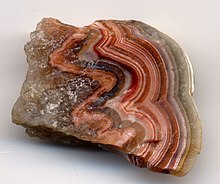
Agate - Hebrew שְׁבוֹ šəḇō; Greek ἀχάτης achates, Latin achates (Exodus 28:19, 39:12, in Heb. and Vulgate; also Ezekiel 28:13 in Septuagint).
This is the second stone of the third row of the priestly breastplate, where it likely represented the tribe of Asher. Hebrew šəḇō was borrowed from Akkadian šubû which itself was borrowed from Sumerian šuba ‘multicolored, agate’. The Greek and Latin names derive from the name of the river Achates (the modern Dirillo) in Sicily where this stone was first found (Theophrastus, "De lapid.", 38; Pliny, "Hist. nat.", XXXVII, liv).
The banded agate belongs to the silex family (chalcedony species) and is formed by deposits of siliceous beds in hollows of rocks. This mode of formation results in the bands of various colors which it contains. Its conchoidal cleavage makes it susceptible to a highly polished state.
Agate is not present in the Land of Israel, the etymology may indicate that it was imported from Mesopotamia, where it is also not native, originally perhaps from the Arabian Peninsula, where the aqeeq (agate) industry is strong.
Amazonite

Amazonite - Hebrew לֶשֶׁם lešem, the first stone of the third row of the priestly breastplate (Exodus 28:19, 39:12), representing Gad. It is missing in the Hebrew of Ezekiel 28:13, but present in the Greek Septuagint.
The Hebrew word lešem is borrowed from the Ancient Egyptian word nšmt, referring to amazonite, a blue-green form of microcline feldspar. The Greek and Latin translations here (Septuagint's λιγύριον ligurion ‘amber’ and Vulgate's ligurius) are probably swapped with another stone or corrupt.
Amber


Amber - Hebrew תַּרְשִׁישׁ taršīš (Exodus 28:20; 39:13; Ezekiel 1:16; 10:9; 28:13; Song of Songs 5:14; Daniel 10:6); Septuagint χρυσόλιθος chrysolithos (Exodus 28:20; 39:13; Ezekiel 28:13); tharsis (Song of Songs 5:14; Daniel 10:6); tharseis (Ezekiel 1:16; 10:9); Vulgate, chrysolithus (Exodus 28:20; 39:13; Ezekiel 10:9; 28:13; Daniel 10:6), hyacinthus (Song of Songs 5:14); quasi visio maris (Ezekiel 1:16); Revelation 21:20, chrysolithos; Vulgate, chrysolithus. This is the tenth stone of the priestly breastplate, representing the tribe of Zebulun. It stands fourth in the enumeration of Ezekiel 28:13 and is given as the seventh foundation stone of the celestial city in Revelation 21:20.
The term taršīš is a product of a fascinating evolution. The word originally referred to an ethnic group in southern Iberia (modern Andalusia), which then became the name of their country, Tartessos. The Phoenicians built large trading ships called an אֳנִיָּה תַּרְשִׁישׁ ʾǒniyyā taršīš to reach this distant location, so over time taršīš came to mean "oceanic" or "maritime." Through a quirk of Hebrew grammar, the phrase אֶבֶן תַּרְשִׁישׁ ʾeb̠en taršīš "stone of the oceanic vessel" was reinterpreted as "taršīš-stone," giving amber its Hebrew name based on the ships that transported it.
The gemstone taršīš is identifiable as Baltic amber, not local Lebanese amber. While Lebanese amber was available, Baltic amber acquired through maritime trade began displacing it in the Levant starting in the 14th century BCE. The amber traveled from the Baltic region through European trading centers to Mediterranean ports via what archeologists call the amber road. The identification of taršīš as amber is supported by the description of the stone in Daniel 10:6 as luminous and warm-colored, coinciding with archaeological evidence of Baltic amber's presence in the ancient Levant during the relevant time period. Unlike other proposed identifications (such as chrysolite, topaz, or tiger's eye), amber was actually known in Ancient Israel.
Amethyst
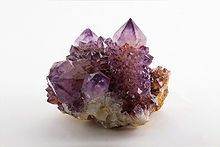

Amethyst - Greek ἀμέθυστος amethystos (Revelations 21:20).
This is the twelfth and last stone of the foundation of the New Jerusalem. Amethyst is not known appear in the Hebrew Bible, as no Hebrew gemstone name can be securely associated with the stone. The Greek name amethystos alludes to the popular belief that amethyst prevented intoxication; as such, drinking vessels were made of amethyst for festivities, and carousers wore amulets made of it to counteract the action of wine.
The amethyst is a brilliant transparent stone of a purple color and varies in shade from violet purple to rose. The amethyst is found in a variety of sizes and easily engraved or shaped.
Aquamarine


Aquamarine - Greek beryllos, Latin beryllus occupied the third place of the second row and in the breastplate, and was understood to represent Nephtali (Ex., xxviii, 19; xxxix, 13). According to the Septuagint, it was the second of the fourth row, and third of the fourth according to the Vulgate. The Septuagint to Ezekiel 28:13 mentions it in the third place, and it is also cited in the Greek text of Tob. 13:17; however, it is missing in the Vulgate. Revelations 21:20, gives it as the eighth stone of the foundation of the New Jerusalem.
Beryl is a stone composed of silica, alumina, and glucina with aquamarine and emerald being the same species of gemstone. The difference between aquamarine and emerald is color and the peculiar shade of each. Aquamarine is a beautiful sea-green variety of beryl.
Aquamarine derives its colour from a small quantity of iron oxide. Beryl occurs in the shape of either a pebble or of an hexagonal prism. It is found in metamorphic limestone, slate, mica schist, gneiss and granite. In ancient times it was imported from India via the Red Sea trade.
Carnelian

Carnelian - Hebrew אֹדֶם ʾōḏem, Greek σάρδιον sardion; Latin sardius; the first stone of the breastplate (Exodus 28:17, 39:10) representing Ruben; also the first among the stones of the King of Tyre (Ezekiel 28:13); the sixth foundation stone of the celestial city (Revelations 21:19). Hebrew ʾōḏem derives from the Hebrew root meaning "red".
Carnelian in Theophrastus (De lap., 55) and Pliny (Hist. nat., XXXVII, xxxi) derive the name of sardion the city of Sardes where, they claim, it was first found. The carnelian is a siliceous stone and a species of chalcedony. Its color is a flesh-hued red, varying from the palest flesh-color to a deep blood-red. It is of a conchoidal structure. Normally its color is without clouds or veins; but sometimes delicate veins of extremely light red or white are found arranged much like the rings of an agate. Carnelian is used for rings and seals. The finest carnelians are found in the East Indies.
Chalcedony, Blue


Blue Chalcedony - Hebrew יָשְׁפֶה yošp̄e, Greek ἴασπις iaspis, Latin jaspis; the twelfth stone of the breastplate (Exodus 28:18, 39:11), representing the tribe of Benjamin. In the Greek and Latin texts it comes sixth, and so also in Ezekiel 28:13; in Revelations it is the first (21:19).
This shared word is part of a large family of similar terms found throughout the Mediterranean and Asia. The ultimate source of these word may lie in a now lost Indo-Iranian form.
In Pliny’s Natural History, iaspis is a generic term that encompasses fourteen types of gemstones. This makes it difficult to determine the identity of the stone intended in the original text, if a particular type was intended at all. Epiphanius mentions that "there is an iaspis, the so-called ancient, which is like snow or sea foam". This fits blue chalcedony, a highly prized gemstone in the Ancient Near East. Because the Septuagint translated yošp̄e with the visually similar stone beryllos "aquamarine" (even though aquamarine was not accessible to the Ancient Israelites), this strongly indicates that yošp̄e should be specifically identified with blue chalcedony.
Chalcedony, Chrome


Chrome Chalcedony - Greek χρυσόπρασος chrysoprasos, the tenth foundation stone of the celestial Jerusalem (Revelations 21:20). This likely refers to a chrome chalcedony (and not a nickel-colored chrysoprase, as the word is used today), which was known in the Roman world at the time. It is a type of green agate, composed mostly of silica and colored green by a small percentage of chromium.
Coral
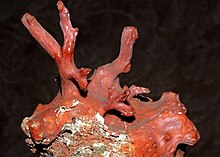

Coral - Hebrew רָאמֹת rāmōth (Job 28:18, Ezekiel 27:16), Greek meteora, ramoth; Vulg. excelsa, sericum. The Hebrew word is cognate to Arabic raʾmat/raʾumat, allegedly some sort of seashell. In one instance the ancient translations went so far as to simply transliterate the Hebrew word.
The Hebrews apparently made very little use of this substance, and it is seldom mentioned in their writings. This also explains the difficulty experienced in scriptural translation. In Ezekiel 27:16, coral is mentioned as one of the articles brought by the Syrians to Tyre. The Phoenicians mounted beads of coral on collars and garments. These corals were obtained by Babylonian pearl-fishers in the Red Sea and the Indian Ocean.
The coral referred to in the Bible is the precious coral (Corallium rubrum), the formation of which is a calcareous secretion of certain polyps resulting in a tree-like formation. Presently coral is found in the Mediterranean, the northern coast of Africa furnishing the dark red, Sardinia the yellow or salmon-colored, and the coast of Italy the rose-pink coral. One of the greatest coral-fisheries of the present day is Torre del Greco, near Naples.
Crystal Quartz
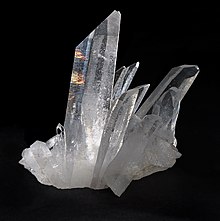

Crystal - Hebrew גָּבִישׁ gāvīsh (Job, 28:18), Greek gabis; Latin eminentia (Job, xxviii, 18); krystallos (Revelations 4:6, 21:11, 22:1). Crystal is a transparent mineral resembling glass, a variety of quartz. Job places it in the same category with gold, onyx, sapphire, glass, coral, topaz, etc.
Diamond


Diamond, Heb. shmyr; Sept. adamantinos; Vulg. adamas, adamantinus (Ezech., iii, 9; Zach., vii, 12; Jer, xvii 1). Whether or not this stone is really diamond cannot be established. Many passages in Holy Scriptures point to the qualities of diamond, in particular to its hardness (Ezech., iii, 9; Zach., vii, 12; Jer., xvii, 1). In the last citation Jeremiah informs us of a diamond usage which is much the same as its usage today: "The sin of Juda is written with a pen of iron, with the point of a diamond". However, although diamond is used to engrave hard substances, other stones can serve the same purpose.
The Septuagint omits the passages of Ezech. and Zach., while the first five verses of Jer., xvii, are missing in the Cod. Vaticanus and Alexandrinus, but are found in the Complutensian edition and in the Syriac and Arabic Versions. Despite the qualities mentioned in the Bible, the stone referred to may be the limpid corindon, which exhibits the same qualities, and is used in India for the same purposes as the diamond. Diamond Color grade ranges from D - Z, where D is the whitest (or colorless) and Z is light yellow or brown.
Because diamond was not very well known among the ancients, and because of the etymological similarity between the words smiris, the Egyptian asmir, "emery", a species of corindon used to polish gemstones, and shmyr, the Hebrew word supposed to mean diamond, the Catholic Encyclopedia speculates that limpid corindon was intended.
Emerald

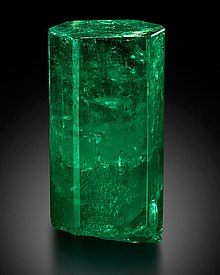
Emerald, Heb. brqm; Sept. smaragdos; Vulg. smaragdus; the third stone of the priestly breastplate (Ex., xxviii, 17; xxxix, 10), representing the tribe of Levi; it is the ninth stone in Ezech., xxviii,13, and the fourth foundation stone of the celestial Jerusalem (Apoc., xxi, 19). The same stone is also mentioned in Tob., xiii, 16 (Vulg. 21); Jud., x, 21 (Vulg. 19); and in the Greek text of Ecclus., xxxii, 8, but there is no indication of it in the Manuscript B. of the Hebrew text, found in the Genizah of Cairo in 1896.
Practically all versions, including Josephus (Ant. Jud., III, vii, 5; Bell. Jud., V, v, 7) translate brhm as "emerald". The Hebrew root brq (to glitter"), from which it is probably derived, is agreed on by scholastic consensus. The word may also derive from the Sanskrit marakata which is certainly emerald nor is the Greek form smaragdos that different either. In Job, xiii, 21; Jud., x, 19; Ecclus., xxxii, 8; and Apoc., xxi, 19, the emerald is certainly the stone referred to. The word bphr also has sometimes been translated by smaragdus but this is a mistake as bphr signifies carbuncle.
Emerald is a green variety of beryl and is composed of silicate of alumina and glucina. Structurally, it is a hexagonal crystal with a brilliant reflecting green colour. The emerald is highly polished and is found in metamorphic rocks, granites, and mica schist. Many of the finest specimens have been found in Muzo, Bogota, South America but the ancients obtained the stone from Egypt and India.
Although claims have been made that the ancients knew nothing of the emerald - Pliny, Theophrastus and others clearly refute this even though the name may have been used possibly for other stones. In the Middle Ages miraculous healing powers were attributed to the emerald, among them; the power to preserve or heal visual problems.
Garnet


Garnet - Hebrew כַּדְכֹּד kad̠kōd̠ (Isaiah 54:12, Ezekiel 27:16) and אֶקְדָּח ʾeḳdāḥ (Ezekiel 27:16), Greek anthrax (Exodus 28:18; xxxix, 11; Ezekiel 28:13; omitted in Ezekiel 27:16), Latin carbunculus (Exodus 28:18; 39:11; Ezekiel 28:13), gemma (Ezekiel 27:16). The carbuncle was the first stone of the second row of the priestly breastplate and it represented Judah, and is also the eighth stone mentioned of the riches of the King of Tyre (Ezekiel 28:13). An imported object, not a native product, (Ezekiel 28:16); it is the third stone of the foundation of the celestial Jerusalem (Revelations 21:19).
Kad̠kōd̠ is used only twice in the Bible, possibly borrowed from a Carian word for this stone. Even more rare, ʾeḳdāḥ is only mentioned once, a word likely loaned from another Semitic language.
Garnet probably corresponded to the anthrax of Theophrastus (De lap., 18), the carbunculus of Pliny (Hist. nat., XXXVII, xxv), and the charchedonius of Petronius. Theophrastus describes it such that, "its color is red and of such a kind that when it is held against the sun it resembles a burning coal." He also relates that the most perfect carbuncles were brought from Carthage, Marseilles, Egypt, and the neighborhood of Siena.
Lapis Lazuli

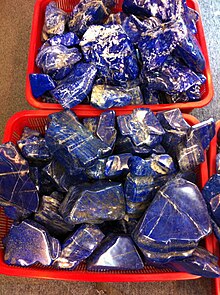
Lapis lazuli - Hebrew סַפִּיר sappīr, Greek σάπφειρος sappheiros, Latin sapphirus. Lapis was the fifth stone of the priestly breastplate (Exodus 28:18, 39:11), representing the tribe of Issachar. It is the seventh stone in Ezekiel 28:13 (in the Hebrew text, but occurring fifth in the Greek translation). The stones is also mentioned with frequency elsewhere (Exodus 24:10, Job 28:6,16, Song 5:14, Isaiah 54:11, Lamentations 4:7; Ezekiel 1:26, 10:1). Sappheiros is also the second foundation stone of the celestial Jerusalem (Revelations 21:19).
Lapis lazuli is frequently confused with sapphire (another blue stone) in the interpretation of ancient texts, but sapphire was scarcely known before the Roman period and the ancients had distinct vocabulary for the gemstones. Lapis lazuli is often speckled with shining pyrites giving it the appearance of being sprinkled with gold dust. It is composed of silica, alumina, and alkali and is an opaque substance easily engraved. Lapis lazuli seems more probable as its qualities are better suited for the purposes of engraving (Lam., iv, 7; Ex., xxviii, 17; xxxix, 13).
Lapis lazuli is one of the most frequently occurring gemstones in the Hebrew Bible, and there is little question as to why. Lapis lazuli is a rock consisting of dark blue lazurite with minute golden specks of pyrite and white patches or veins of calcite. The visual appearance of lapis lazuli appears like the constellated night sky, the pyrite particles resembling stars, and calcite bands galaxies in a dark-blue celestial canopy. Two of Ezekiel's references to the stone (1:26, 10:1) echo Exodus 24:10 in likening the night sky to sappīr.
In the Ancient Near East, an association between lapis lazuli and the divine was a common cultural motif, born of the resemblance of the stone to the night sky. This association is implicit in the Hebrew Bible, and is the likely origin of the biblical commandment to wear a string of tekheleth on the fringes of ones' garment.
The source of lapis lazuli in the Ancient Near East was Badakhshan, the same location where the stone is primarily mined today.
Jasper, Red

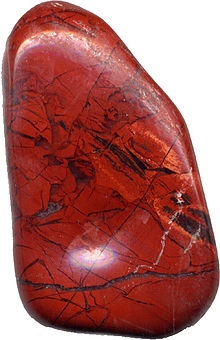
Red Jasper - Hebrew אַחְלָמָה ʾaḥlāmā.
Red Jasper is the third stone in the third row of the priestly breastplate, representing the tribe of Issachar (Exodus 28:19, 39:12); the Septuagint enumerates it among the riches of the King of Tyre (Ezekiel 28:13).
The gem is an anhydrate quartz composed of silica, alumina, and iron and there are jaspers of nearly every colour. It is a completely opaque stone of a conchoidal cleavage. It seems to have been obtained by the Jews from Egypt.
Onyx


Onyx - Hebrew שֹׁהַם shoham, Greek ὀνύχινος onychinos, Latin lapis onychinus. The eleventh stone of the breastplate in the Hebrew and the Vulgate (Exodus 28:20, 39:13), representing the tribe of Joseph. In the Septuagint it is the twelfth stone and the fifth in Ezekiel 28:13 in the Hebrew, but the twelfth in the Greek.
Genesis 2:12 mentions that shoham occurred in the Land of Havilah, the onyx of the Arabian peninsula must be intended here. I Chronicles 29:2 mentioned that David left shoham be used in the building of the First Temple. As the Queen of Sheba visited Solomon shortly thereafter, where onyx originated from the same geographical area, this detail suggests that Arabian onyx found its way to Israel circa 10th century BC.
Onyx is a variety of quartz analogous to agate and other crypto-crystalline species. It is composed of different layers of variously colored chalcedony much like banded agate in structure, but the layers are in even or parallel planes. This makes it well adapted for the cutting of cameos and was much used by the ancients for that purpose. The colors of the best are perfectly well defined, and are either white and black, or white, brown, and black.
Pearl


Pearl - Hebrew פְּנִינִים pənīnīm, Greek μαργαρίτης margarites, Latin margarita. Mentioned frequently in the Old Testament, in Job, 28:18; Proverbs 3:15; 8:11, 20:15, 31:10, Lam., 4:7. In the New Testament, pearls are mentioned in Matthew 7:6, 13:45-46, I Timothy 2:9, and Revelations 17:4, 18:12, 16, 21:21.
It is comparatively certain that pearl was known among the Jews, at least after the time of Solomon, as it was among the Phoenicians. The exact etymology of pənīnīm is uncertain.
Pearl is a concretion consisting chiefly of lime carbonate found in several bivalve molluscs, but especially in Avicula margaritifera. Generally, it has a whitish blue hue, sometimes showing a tinge of pink; but there are also yellow pearls. Pearl was considered the most precious of all among the ancients, and was obtained from the Red Sea, the Indian Ocean, and the Persian Gulf.
Sapphire


Sapphire - Greek ὑάκινθος hyakinthos; Vulg. hyacinthus ; the eleventh stone of the foundation of the heavenly city (Revelations 21:20).
The genuine sapphire is a beautiful blue hyaline corundum and is composed of nearly pure alumina, its color resulting from the presence of iron oxide. Sapphire was obtained from India.
Lapis lazuli is frequently confused with sapphire in the interpretation of ancient texts, but sapphire was scarcely known before the Roman period and the ancients had distinct vocabulary for the gemstones.
Sardonyx


Sardonyx - Under the name sardonyx, it comes fifth in Revelations 21:20. Sardonyx is technically a variety of onyx (see above), marked by red-and-white bands instead of black-and-white. Sardonyx began to be held in high esteem in Ancient Rome after Scipio Africanus began to wear one.
Peridot


Peridot - Hebrew פִּטְדָה piṭḏa, Greek τοπάζιον topazion, Latin topazius. The second stone of the priestly breastplate (Exodus 28:17, 39:19), representing Simeon; also the second stone in Ezekiel 28:13; the ninth foundation stone of the celestial Jerusalem (Rev. 21:20) and also mentioned in Job 28:19.
Hebrew piṭḏa and Greek topazion are likely related words, the term originating from an African language of the Red Sea region. The etymology remains obscure.
In the ancient world, peridot originated exclusively from Zabaragad Island in the Red Sea.
See also
References
- Herbermann, Charles, ed. (1913). "Precious Stones in the Bible" . Catholic Encyclopedia. New York: Robert Appleton Company.
- Harrell, James A. (2011-01-01). "Old Testament Gemstones: A Philological, Geological, and Archaeological Assessment of the Septuagint". Bulletin for Biblical Research. 21 (2): 141–171. doi:10.2307/26424638. ISSN 1065-223X.
- ^ Exodus 28 | NLT Bible | YouVersion.
- ^ Exodus 39 | NLT Bible | YouVersion.
- ^ Ezekiel 28 | NLT Bible | YouVersion.
- ^ Ayil, Ephraim S. (2024-08-26), "Identifying the Stones of Classical Hebrew: A Modern Philological Approach", Identifying the Stones of Classical Hebrew, Brill, ISBN 978-90-04-67800-2, retrieved 2024-12-29
- See, for example: The earliest reference to amethyst as a symbol of sobriety is in a poem by Asclepiades of Samos (born ≈320 BCE). See "XXX. Kleopatra's Ring" in: Edward Storer, trans., The Windflowers of Asklepiades and the Poems of Poseidippos (London, England: Egoist Press, 1920), page 14. An epigram by Plato the Younger also mentions amethyst in connection with drinking: "The stone is an amethyst; but I, the tipler Dionysus, say, "Let it either persuade me to be sober, or let it learn to get drunk." See George Burges et al., The Greek Anthology,... (London, England: George Bell and Sons, 1881), p. 369. Pliny says about amethysts: "The falsehoods of the magicians would persuade us that these stones are preventive of inebriety, and that it is from this that they have derived their name." See Chapter 40 of Book 37 of Pliny the Elder's The Natural History.
- Platz-Horster, Gertrud (2010-10-01). "Kleine Praser and Chromium-bearing Chalcedonies. About a small group of engraved gems". Pallas. Revue d'études antiques (83): 179–202. doi:10.4000/pallas.10993. ISSN 0031-0387.
- ^ Harrell, James E.; Hoffmeier, James K.; Williams, Kenton F. (2017-01-01). "Hebrew Gemstones in the Old Testament: A Lexical, Geological, and Archaeological Analysis". Bulletin for Biblical Research. 27 (1): 1–52. doi:10.5325/bullbiblrese.27.1.0001. ISSN 1065-223X.
- "Diamond Color". GemsNY Corp. Retrieved 2024-08-22.
- "Pliny the Elder, The Natural History, BOOK XXXVII. THE NATURAL HISTORY OF PRECIOUS STONES., CHAP. 23.—SARDONYX; THE SEVERAL VARIETIES OF IT. DEFECTS IN THE SARDONYX". www.perseus.tufts.edu. Retrieved 2025-01-12.
Further reading
- Attribution
- [REDACTED] This article incorporates text from a publication now in the public domain: Souvay, Charles (1912). "Precious Stones in the Bible". In Herbermann, Charles (ed.). Catholic Encyclopedia. Vol. 14. New York: Robert Appleton Company. The entry cites:
- ST. EPIPHANIUS, De duodecim qemmis in Patrologia Graeca, XLIII, 294–304;
- ST. ISIDORE, De lapidibus in Etymol., xvi, 6–15, in Patrologia Latina, LXXXII, 570–580;
- Charles William King, Antique Gems (2d ed., London, 1872);
- —, The Natural History of Gems or Decorative Stones (2d ed., London, 1870);
- BRAUN, Vestitus sacerdotum hebræorum (Leyden, 1680);
- BABELON in DAREMBERG AND SAGLIO, Dict. des antiquités grecques et romaines, s.v. Gemmæ;
- LESÉTRE in VIGOUROUX, Dict. de la Bible, s.v. Pierres précieuses;
- ROSENMÜLLER, Handbuch der biblischen Alterthumskunde (Leipzig);
- WINER in Biblisches Realwörterbuch (Leipzig, 1847), s.v. Edelstine.